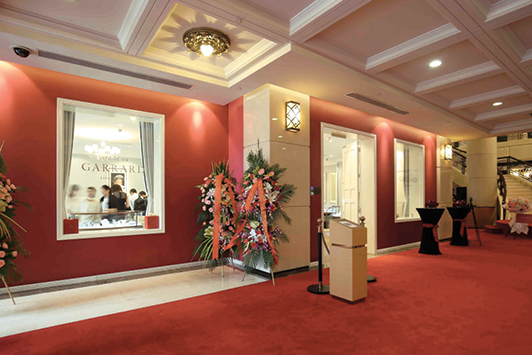
There’s been a rush of luxury jewelry companies entering the Chinese market. In August alone, British high jeweler Garrard, Italian high jeweler Buccellati, and Swiss luxury watch and jewelry manufacturer Chopard all announced plans either to enter or to expand in China.
What these companies see in China is a large population, a rapidly rising middle class (particularly in second- and third-tier cities), a fragmented retail landscape, a dynamic online environment and a young population with a desire for jewels — particularly from established global brands.
The statistics bear this out. In the last five years, total revenue for jewelry stores in China has grown at an estimated annual rate of 8.3%, reaching $102.8 billion in 2017, according to a July report by market research firm IBISWorld. Over the next five years, industry revenue is expected to increase 5.8% per year to hit $136.3 billion in 2022. China is the largest consumer of gemstone, jade, platinum and gold jewelry in the world, and the second-largest consumer of diamond jewelry.
In a market dominated by gold, the potential for growth in diamonds seems to provide one of the biggest opportunities for the industry. Diamond jewelry currently accounts for only 15% of the country’s total jewelry sales, according to the IBISWorld report, titled “Jewelry Stores in China.”
This growth potential is not lost on luxury jewelry brands.
“With a population of nearly 1.4 billion, a rising GDP and an ever increasing awareness of the quality and investment value of precious stones and jewelry, China continues to be the largest emerging market for luxury goods,” says Joanne Milner, CEO of Garrard, which opened its first Chinese boutique in Shanghai in August and plans to open a second location “in another major Chinese city at the beginning of 2018.”
“The potential is immense,” agrees Chopard co-president Karl-Friedrich Scheufele. “There is a growing middle class with disposable income, who want to own a special piece of jewelry or timepiece.”
Small, independent stores dominate China’s retail landscape. The country’s five largest retailers — Chow Tai Fook, Lao Feng Xiang, Shanghai Yuyuan Tourist Mart, Beijing’s Caishikou Department Store, and China National Gold Group Corporation — account for just 17.5% of jewelry sales, according to IBISWorld.
The best news in the report for global jewelry brands is that foreign jewelry retailers, which represent only 1.6% of the total number of jewelry retailers in China this year, are expected to account for 15.2% of total industry revenue for the country due to their large operating scales. It also shows the importance of global brands to Chinese consumers.
“We’ve noticed that branded jewelry backed by celebrity marketing has become an impactful window for retail,” Scheufele remarks.
Indeed, the increase in sales from Chinese tourists at Garrard’s London flagship store was a major driver of the company’s expansion into China, Milner says. “China’s continued passion and interest for British royal heritage and traditions means that Garrard’s unique and unrivaled royal legacy is fast becoming a more desirable asset within this market.”
Buccellati, renowned for creating jewels using time-honored hand-crafting techniques by Italian artisans, was acquired by Chinese holding company Gangtai Group in August. One of the main incentives for the purchase was the promise of opening 88 branded boutiques, with China being a primary market for expansion. Buccellati currently has wholesale distribution in the country.
Even luxury brands with a strong retail presence in China are expanding in new ways. For example, Chopard, which has 15 boutiques and a wholesale network in China, has launched an e-commerce concept store on JD.com, one of the country’s largest online retailers. The online experience includes JD Luxury Express, the exclusive white-glove delivery service JD.com recently introduced.
Scheufele says the decision to go online in China was straightforward.
“The Chinese consumer tends to spend more time on e-commerce sites [than people in] the West,” he explains. “There is a younger generation of shoppers who feel very at ease and comfortable with purchasing luxury products online.”
IBISWorld’s report predicts that growth in jewelry retail will continue at a broad, steady pace.
“The industry globalization level is expected to increase in future years, as the growing domestic jewelry market attracts more global jewelry retailers to China,” it said. “In addition, with the rapid expansion of franchise stores, the presence of existing foreign jewelry retailers will grow in second- and third-tier cities.”
Austerity measures that Chinese President Xi Jinping instituted in 2012 to crack down on corruption initially led to losses in jewelry and watch sales, but the industry seems to have adjusted. In fact, Milner speculates the measures will have more of an impact on Garrard’s London branch than on its Shanghai boutique.
“The Chinese government continues to tighten its control on large transactions and overseas spending, [encouraging] Chinese nationals to invest more in their own economy by spending within China,” she says. “While this poses a challenge [as far as] Chinese clients spending internationally, it can also be considered a key time to expand retail businesses into mainland China.”
Image: House of Garrard opened its first boutique in Shanghai this summerArticle from the Rapaport Magazine - September 2017. To subscribe click here.